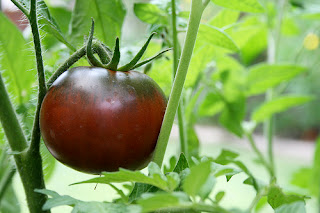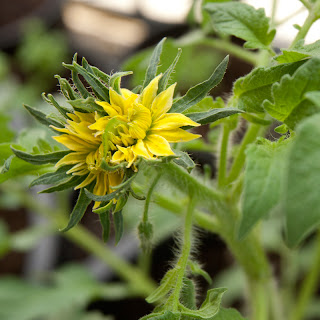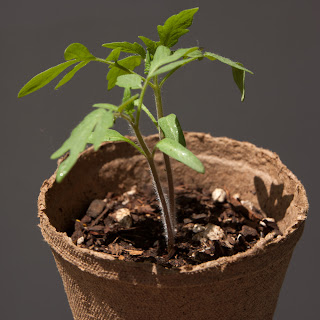An Intro to Black Krim Tomatoes
 MY STATUS: Unsuccessful
MY STATUS: Unsuccessful The Black Krim cultivar originates on the Crimean Peninsula of the Ukraine. It's an indeterminate type of tomato, meaning that it will continue to produce fruit as long as the weather is sufficiently warm--a good choice for Pohnpei's endless summer temperatures. Black Krim tomatoes tend to be medium-sized to large (gardeners call tomatoes of this size "beefsteak"). They are dark maroon with green or brown patterns on the shoulders and a deep purple flesh. Black Krim are known for their rich flavor and are a perfect tomato for salads and sandwiches. Plants can grow to a height of 40 inches and take 80-100 days to mature. I used Ferry-Morse seeds purchased at Home Depot in Southern California in early winter and sowed them in starter pots about one month later.
SUN, SUN, SUN
 Like any other tomato, Black Krim tomatoes need tons of sun and plenty of heat to achieve maximum productivity. Too little UV and the plants will just carry on without flowering. With an average of only two cloudless days a year on Pohnpei, my guess is that the bumper crops you would get in a place like California are probably out of reach. But, we'll see. So far I haven't met anyone here who has tried to grow this variety, but I chose it because it is supposedly more tolerant to extreme humidity than other tomatoes. Plus it's super yummy and visually delicious as well!
Like any other tomato, Black Krim tomatoes need tons of sun and plenty of heat to achieve maximum productivity. Too little UV and the plants will just carry on without flowering. With an average of only two cloudless days a year on Pohnpei, my guess is that the bumper crops you would get in a place like California are probably out of reach. But, we'll see. So far I haven't met anyone here who has tried to grow this variety, but I chose it because it is supposedly more tolerant to extreme humidity than other tomatoes. Plus it's super yummy and visually delicious as well! RAIN PROTECTION
Tomatoes don't like to be wet. They need to be watered deeply two or three times a week, depending on how much sun they're getting, but will drown, rot, or develop fungal infections if exposed to Pohnpei's rains. Blossom-end rot is the result of the opposite extreme--too little water. Use the four-inch soil test to determine when to water.
BUGS
 After bacterial and fungal infections, pests are the next biggest threat. Many varieties of worms, beetles, mites, aphids, and whiteflies consider tomato plants scrumptious. As soon as I get a complete verified list of the pests found on Pohnpei, I'll post it on this blog. Hornworms, which are notorious for ravaging tomatoes elsewhere, may not be present here. I'm looking into it. Whiteflies are rampant and can easily get out of control. I've already encountered a few and have taken steps to prevent them from multiplying.
After bacterial and fungal infections, pests are the next biggest threat. Many varieties of worms, beetles, mites, aphids, and whiteflies consider tomato plants scrumptious. As soon as I get a complete verified list of the pests found on Pohnpei, I'll post it on this blog. Hornworms, which are notorious for ravaging tomatoes elsewhere, may not be present here. I'm looking into it. Whiteflies are rampant and can easily get out of control. I've already encountered a few and have taken steps to prevent them from multiplying.CROSS-POLLINATION ALERT
If you're growing multiple types of tomatoes at the same time and in close proximity, they can cross-pollinate. This won't affect the current generation of plants in any way, but if you plan to gather seeds from your plants for a second generation, you could end up with some strange unintended hybrids.
What I Did
DAY 1 - SOWING
I planted my seeds in small biodegradable starter pots filled with store-bought garden soil--a 1/2 inch hole in the middle and a few seeds in the bottom. I covered the seeds and gave the pot 1/2 medicine cup of water a couple of times during the day, keeping the soil moist but not soggy.DAY 5 - GERMINATION
Several Black Krim seedlings shot up on the fifth morning after planting (left).DAY 8 - THINNING
The seedlings have reached a height of about 2 inches (right) with thick, hairy stems. I pulled out all but the two tallest, most robust seedlings in each pot. This is a prime example of artificial selection. By keeping only the fastest-growing, healthiest seedlings, you're increasing your chances of success.DAY 13 - APPLICATION OF FISH EMULSION
I've begun watering with a solution of Alaska Fish Emulsion. The seedlings are looking happy.DAY 25 - TRANSPLANTATION
I unintentionally let my seedlings go a lot longer than I should have without planting (left). I got occupied with other things and they stayed in their starter pots until I noticed that they seemed to be showing the effects of crowding. I hurried to prepare my pots for planting.SOIL PREPARATION:
- I used a 5.5 gallon pot for each tomato plant to give the roots plenty of room to expand.
- First, I poured in a 2-inch layer of medium basalt gravel (rinsed). This layer and the following one are there to help the soil stay drained, so the roots of the plants don't rot.
- Second, I poured in a 1-inch layer of fine black sand. Sand can be purchased at the APSCO Gravel Quarry on Sokehs Island. A 20-kg bag of fine blasting sand costs $5.00. Wash before using.
- Next, I added a 1-inch layer of steer manure. Once the roots get down toward the bottom of the pot, they'll find a reservoir of extra nutrients.
 |
 |
 |
- Finally, the pots were filled nearly to the brim with a balanced mixture of store-bought garden soil and Miracle Grow Potting Mix. Nothing really fancy. I'll add liquid fertilizer as my plants develop.
- In each pot, I dug a trough about 1/2 inch deep and several inches long and buried my plant stem horizontally in the trough so that only the very top of the plant (including the cotyledons and true leaves) were above ground (below). I did this to counteract the legginess of the plants and encourage greater root development. All those little hairs on the stem will turn into roots and the plant will end up well-anchored and nice and stocky, requiring less artificial support. I pressed the soil down a bit and watered quite deeply.
DAY 31 - INSECTICIDAL SOAP SPRAY APPLICATION
I discovered a few whiteflies on the underside of my pepper plant leaves this morning. When I checked the tomato plants, I found one or two on the cherry tomatoes--which are the most developed of the six plants I have. I killed them and then went and bought some insecticidal soap spray at Pohnpei Ace Hardware. I gave all the plants a spray. I'm also looking into creating some whitefly traps. Apparently, the adult flies are attracted to yellow, so if you cover something yellow with a sticky substance, they will land on it and get stuck. People have also told me that garlic repels whiteflies. I need to test that theory.DAY 32
A couple of the leaves have faint dark patches on them. I looked this up, worried that it might be some disease, but it looks like it is probably an effect of the soap spray applied yesterday. It is soap after all; even if it is intended for plants, it must cause some minor cellular damage. I'll keep a close eye on it. Hopefully, they will be okay. Haven't seen any whiteflies since the treatment (right).DAY 33
We've had a run of spotty weather lately with a few hot, sunny days scattered amongst many dark, overcast days. The problem with this is that the plants adapt to the sunless weather, becoming more sensitive to light. Then when it gets sunny again, they are shocked by the sudden change and wilt in the fierce rays. I've found that the way to deal with this is to mist the plants with ice water. I only do it when it's super hot and the water is going to quickly evaporate. It provides the plants the same benefits we get from sweating; the evaporation process cools the plants down. There are risks, however, and I've been watching carefully for any sign of fungi. So far, so good.Both Black Krim plants are about 3.5 inches tall now. Though they germinated before my German Green's, they have grown slower and are slightly smaller with less advanced leaf development. One of the plants is shorter and scrawnier than the other, but they seem to be fine and growing well now that they're in a deep pot.
DAY 49
The Krims are chugging along. They haven't grown at quite the break-neck speed of the cherry tomatoes, but then they are larger plants overall. Both plants are about 12 inches tall with thick, sturdy stems. I've found and killed some whiteflies here and there over the last couple of weeks, but the plants are not infested and seem very robust and healthy.I wasn't really watering any of the tomatoes properly in the beginning, but I've got that process down now. Shallow watering = bad. Deep watering = good. Do the 4-inch soil test to gauge when to water rather than watering on a schedule. Dig a little four inch deep hole. If the soil is damp at that depth, do not water. If it's dry, give the plant enough water that there is one standing inch above the soil. Excess water will drain through if you've prepared your pot and soil right. The point is that the soil needs to get wet all the way to the bottom. If you water shallow as I was doing, the plant's roots don't grow down because there is plenty of water near the top. On the other hand, if you water deeply, the very bottom of the pot is the last place to retain moisture. As the soil dries out, the plant is forced to dig deeper to find the water it needs.
DAY 58
The plants are about 14-15 inches tall now and look good with very thick stems. They seem to be doing great . . . but they shouldn't be anywhere near mature yet at only 58 days; Black Krim usually take 80-85 days to reach fruiting age. They're much shorter than the cherry tomatoes were when they started flowering. And yet, here they are developing HUGE flowers already! If they end up fruiting earlier than expected, I'm certainly not going to complain, but it is strange. The flowers are very different from the ones on the cherry tomato plants; not only are they massive, but they're shaped differently and have many more petals. They almost look like miniature sunflowers. |
 |
DAY 70 - FLOWERING
I'm not sure what the initial giant blossom was all about, but one of the two Krims now has more normal size flowers on it and a whole cluster of receptacles that haven't yet bloomed. One of the plants is about 4 feet tall, while the other is at least a foot shorter. I'm not sure why. I've been vibrating the flowers a couple of times daily to ensure pollination.DAY 110 - DECLINING HEALTH & TERMINATION
The Krims, along with two cherry tomatoes, and two German Green plants all succumbed to the effects of whitefly infestation. Catastrophic leaf loss and increased stress caused by whiteflies constantly sucking the sap of the plant rendered the brief period of flowering useless. Most flowers either did not pollinate or dropped off when I attempted to vibrate them. After the first bloom, there were no others. I pulled up and disposed of all six tomato plants to save my other plants; unhealthy plants just draw more and more pests. When the plants were pulled up, it was obvious that they were pot-bound and that larger containers would be needed for future attempts.SECOND ATTEMPT
DAY 1 - NEW SEEDLING TRANSPLANTATION
Today I planted a new Black Krim plant that I started from seed about a month ago. The seedling was planted in a huge pig feed bag with a layer of gravel at the bottom and filled with potting soil. This bag will provide the plant about three times the growing space of the pots I used during my first tomato run. Hopefully, that will help. Additionally, whiteflies are not present, and the plants are getting maximum sunshine in the garden shelter on the roof. Two Cherokee Purple plants from thissame batch, however, came down with Tomato Yellow Leaf Curl Virus, so I'm hoping these are not also infected. The other plants did not show signs until about two weeks after transplantation.















.jpg)







0 comments:
Post a Comment